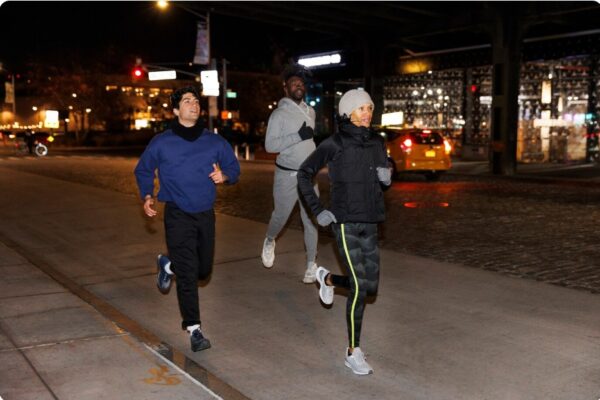
📈 Marathon Training Is About Progression
Marathon training isn’t just logging miles. It’s an evolving process that balances duration, intensity, variation, and recovery to bring your body to its best shape by race day. For me, the real shift came when I began measuring success not just in speed, but in how I felt. This internal awareness built resilience I could rely on when my GPS watch failed or when my race nerves kicked in.
As the weeks went by, I noticed that tuning into my own sensations gave me a better picture than any app. My progress wasn’t just visible in finish times—it was in how I could push through the hard miles or slow down when I needed rest.

⚖️ Why Intensity Matters in Marathon Training
Your body adapts very specifically to the intensity you train at. That’s why your easy runs should truly feel easy, and your harder runs should challenge you just enough. If everything feels the same, your body stops improving. I found this out the hard way—running all my training at a medium pace left me burned out and stagnant.
Once I began incorporating purposefully paced runs, I started to notice real breakthroughs. My easy runs actually became refreshing, and my race paces felt sustainable, not punishing.
🎯 Borg Scale – Train by Perception, Not Tech
The Borg Scale of Perceived Exertion is a simple 6–20 point scale that helps you assess intensity based on how hard you feel you’re working. No gadgets. No metrics. Just you.
When I started using it, I was skeptical. But I quickly discovered that my body was a more honest coach than any app. I learned the art of listening—to my breathing, my stride, and even my thoughts. Some runs that I thought were “sluggish” ended up being right in the zone. Others that I pushed too hard on taught me valuable pacing lessons.

The magic? It’s always available. On the trail, treadmill, or your neighborhood streets.
👟 Best Running Shoes for Body Awareness
If you’re training without tech, your shoes become your main connection to the road. Look for running shoes with good ground feel and reliable cushioning. The right shoe won’t just carry you forward—it’ll help you feel every stride, every change in terrain, and every signal your body sends.
I’ve tested bulky, plush shoes and minimal racing flats. Somewhere in the middle was my sweet spot—shoes that made me feel light but protected. Let your feet speak too.
📊Modified Borg Scale – Understand Your Effort Level
The original Borg scale ranges from 6 to 20, roughly corresponding to heart rate (60–200 bpm). In running, we simplify this to match breathing and perceived effort.
Here’s a helpful breakdown:
| Borg Score | Feeling | Breathing | Talking Ability |
|---|---|---|---|
| 💚 6–9 | Very Easy | 😌 Calm | 🗣️ Full sentences |
| 💙 10–12 | Easy | 😊 Comfortable | 💬 Can chat |
| 💛 13–14 | Moderate | 😤 Noticeable | 🗨️ Short phrases |
| 🧡 15–16 | Hard | 😮💨 Deep, faster | 🧏 Brief phrases |
| ❤️ 17–18 | Very Hard | 😫 Heavy | 🗯️ A few words |
| 🔴 19–20 | Max Effort | 😵💫 Gasping | 🤐 Nearly silent |
🧪 Training Examples Using Borg Scale
🐢 Easy Pace (10–14 Borg)
If you can hold a conversation, you’re in the zone. This is where beginners build endurance. I used to call these my “mental reset runs.” They’re the miles that don’t just build fitness, but also build joy. I’d finish these with more energy than I started with.
🚶 Moderate Pace (15–16 Borg)
Breathing picks up. You can speak, but you’re focused. These runs trained me for the middle miles of a race—steady, strong, controlled. They helped me simulate race-day pacing, staying just below the red line.
🔥 High Effort (17–18 Borg)
Your legs burn, breathing’s heavy. This is tempo or hill effort. Do it sparingly. I often reserved these for mid-week short bursts. These efforts taught me patience, humility, and the grit to finish strong.
🏁 Very High (19–20 Borg)
Think sprint finishes or 5K races. These are short and sharp. Use them to test your grit but don’t overdo it. I rarely go here unless I’m sharpening before a race or chasing a personal best.

💓 Medical Uses – A Reminder of Simplicity
In hospitals, the Borg scale helps heart patients measure exercise intensity when electronic monitors aren’t reliable. It works because it’s human-centered. Running is no different.
The scale empowers individuals—whether recovering or performing—to be in control. It reminds us that health and fitness are not only about numbers but how those numbers translate into real-life effort, safety, and joy.
🧘 Final Thoughts
If you’re drawn to nature, mindfulness, or simply getting away from screens, training with the Borg scale may become your favorite tool. In a world that often values numbers over feelings, the Borg scale is a return to self-awareness.
Whether you’re chasing a finish line or just a better feeling in your daily runs, it can reconnect you with your “why.” Running becomes less of a performance—and more of an experience.
It’s not just about going faster. It’s about going deeper.
❓ FAQ – Borg Scale & Running
Q1: Is the Borg scale accurate for beginners?
Yes—it’s designed for subjective use and works well for all fitness levels.
Q2: Can I combine it with heart rate training?
Absolutely. Many experienced runners use both to fine-tune workouts.
Q3: Should I use the Borg scale on every run?
Start with easy and long runs. Add it to others as you grow more confident.
Q4: What if I’m wrong about how I feel?
Perception improves with practice. Trust your learning curve.
💬 “You don’t need a watch to know your worth. You just need to feel your feet, your breath, and your heart.”






Hi,
I really want to say a big thanks to you for sharing this insightful and informative article on the topic titled;borg scale in a marathon training. I really find this article interesting. I never really had much knowledge on the uses of Borg scale in marathon training. I think Borg scale is really very useful and nice. This is really educational.
Hi Oscar
Thank you for the comment. Happy that you find it interesting and educational.
Be Well
Hello dear, thanks a lot for sharing such an amazing and informative article on the topic Borg scale in marathon training I actually came across this site I was not so sure of it sincerity but to my surprise it really hold quality information though I don’t know much about Borg scale your explicit expression on this topic has really thought me a lots I have already save this website for recommendation and future reference thanks once more
Hi mondayjosep
Thank you for your comment, your compliments and that you could use some of it. I really appreciate it.
Be Well
Hey nice article you have there, your thoughts are indeed invaluable. The rate of perceived exertion can be useful for in season training when strength levels fluctuate due to changes in daily readiness and fatigue among athletes and cyclist. The need to measure the intensity of ones exercise to guarantee maximum efficiency cannot be overemphasize
Hi edahnewton1
Thank you for your comment.
I agree in your thoughts about measure the intensity.
Be Well